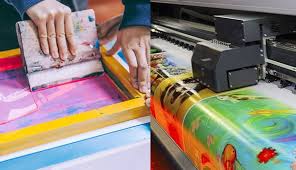The Main Difference Between Digital Printing And Regular Printing

Digital printing supports quick turnaround times, on-demand production and enables you to print variable data. It also offers higher precision, color match capabilities and less waste.
It is suited to smaller volume jobs that require a lower rate. This is because it avoids the upfront costs of etching aluminium plates and rubber sheets.
Cost
Digital printing provides a lower per-print cost than traditional print methods. This is because it does not require the creation of master plates or excessive ink usage. Furthermore, it is more environmentally friendly and allows for quick turnarounds and variable data printing. It also eliminates the need for storage and warehousing costs, which can reduce waste and save money.
Digital printers use electrostatic rollers called drums to apply toner and color onto a sheet of paper. These drums have an electrostatic charge that attracts toner, allowing it to fuse to the paper using high heat and pressure. This process produces a very high quality, sharp image that can be used for a variety of projects.
However, digital printing has some limitations. For example, the inks that are used with this method cannot match Pantone colors very well, and digital printing may not produce a very precise result when it comes to gradients. This is a downside that could be significant for some jobs. Visit here manish web.
Speed
Digital printing uses a special machine that maps out minute droplets of ink onto the chosen surface to create an image. The process allows for quick turnaround, which is ideal for projects that have a tight deadline.
The process works best for items that require high amounts of detail, such as photographic prints or graphic designs. Since it doesn’t use screens, it can produce much thinner layers of ink than screen printing, which results in a sharper image.
Additionally, unlike traditional printing methods, digital printing doesn’t require master plates to be replaced between runs, which helps reduce setup time. This makes it the perfect option for high-volume variable data jobs in transaction printing or direct mailers, as well as for shorter print runs where a quick turnaround is important. Moreover, unlike other types of printing, digital printing doesn’t use wet inks. This means it’s also far more eco-friendly than other printing methods. This is because digital printing conserves energy by bypassing many of the processes that standard printing does.
Eco-friendliness
Digital printing is a modern technique for printing digital-based images directly onto various media substrates. Unlike screen printing, it doesn’t require a plate and works through either an inkjet or laser printer. This makes it a great option for smaller print runs or projects that are time-sensitive.
It is also a more eco-friendly method because it doesn’t produce as much waste. With this type of printing, only ink is injected into areas where it is needed, which means less mess and cleanup. Plus, digital printing uses polymer inks that are less harmful to the environment than traditional solvent-based inks.
Digital printing is an excellent choice for quick turnaround projects because it allows you to print on demand. This eliminates the need to carry inventory, which saves you money and space. It is also ideal for marketing campaigns that require a limited release because it allows you to create a unique product each time. Additionally, digital printing offers high-quality color and a minimal amount of dot gain.
Quality
Digital printing is a form of printing from a digital-based image directly onto a range of media substrates. It doesn’t use metal plates like offset printing does, but rather prints the digital file onto your chosen substrate using liquid ink or laser toner. It is a more accurate process than screen printing because it allows for much greater detail to be printed.
It also uses fewer resources, is less labour-intensive and offers faster turnaround times. It also supports just-in-time delivery and eliminates warehousing costs and waste. Plus, it allows for easy changes to print jobs that require variable data, such as coupons or direct mail campaigns.
This makes it ideal for small run printing of items that require a modern, crisp finish and is a great alternative to screen printing. This method also allows for a higher level of color options, unlike the limited amount offered by traditional screen printing. It can include up to six colors on a single unit.







